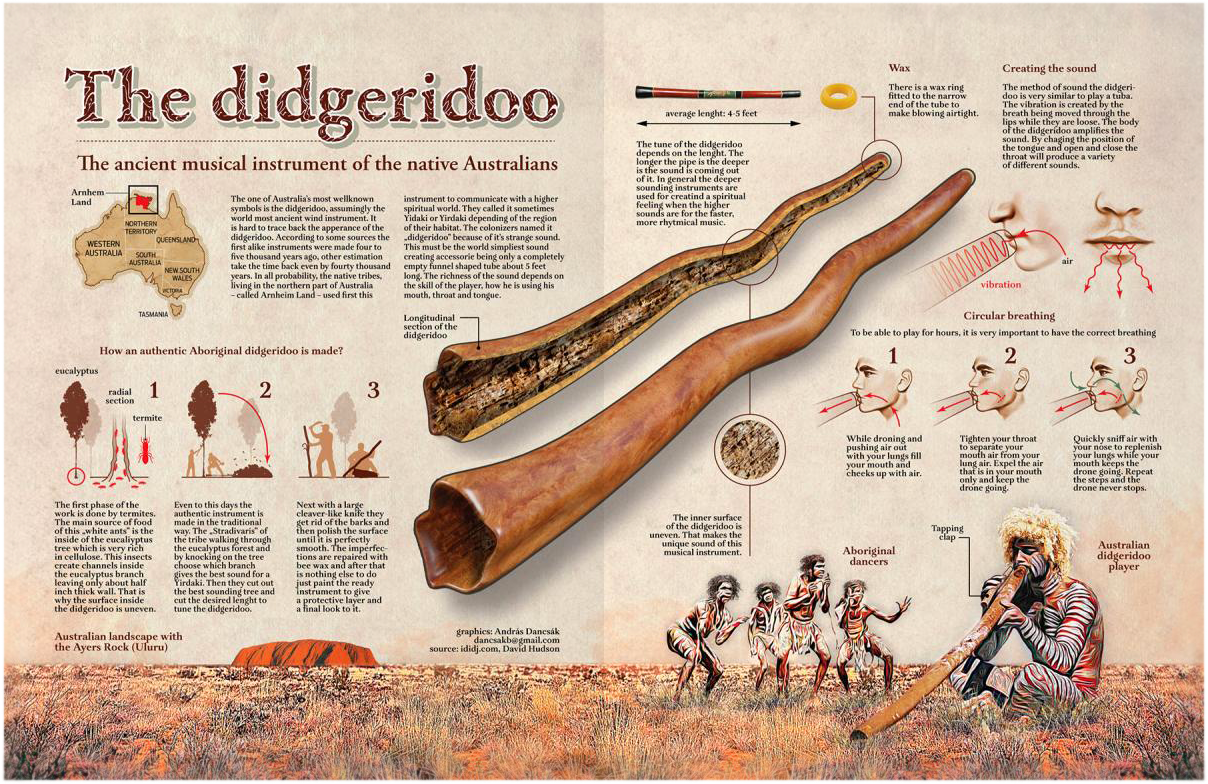The didgeridoo (Yidaki)
The didgeridoo (pronounced: didscheriduu) is one of the traditional musical instruments of the indigenous people of Australia - the Aborigines. Real didgeridoos are made from branches of a eucalyptus tree hollowed out by termites. These branches come from trees that are about five to six meters high and about 15 cm in diameter. Termites know how to hollow out a four meter high tree! The didgeridoo craftsmen know exactly which tree is usable, and they take only a few branches from each tree so that it stays alive.
In the cultures of the aborigines of Australia there are probably several names for the "Didgeridoo". One name used by many Aborigines is Yedaki. Other names include Yidaki, Yirdaki, Uluhuru, Gurrmurr, Gindjunggang, etc. The didgeridoo is at least two thousand years old, but could be significantly older. The Australian aborigines use the wind instrument mainly at festivals and ceremonies for the rhythmic accompaniment of songs and dances.
![]()

The sound and tones of the didgeridoo - incomparable, pure and earthy. For the Australian aborigines it is a sacred sound that influences consciousness. In its sound you can hear nature. The howling of an animal, the vibrating heat of the dry outbacks, the vast plains of Australia. These are the deep origins of this kind of didgeridoo music. - In search of the fascination of the didgeridoo -

![]()
"He who knows the mystery of sounds knows the mystery of the whole universe."
- Hazrat Inayat Kahn -![]()
Didgeridoo and the health - the way to healthy breathing
An instrument with healthy side effects!
Breathing training
Playing the didgeridoo has an extremely positive effect on health. Playing the didgeridoo involves a special breathing technique. Regular playing can train the respiratory muscles and thus positively influence breathing. The vibration of the instrument is transmitted to the person and affects the bone structure. Therefore, it can be used very well in rheumatic diseases and osteoporosis. In addition, when played, it also counteracts respiratory diseases and snoring problems. The increased breathing and lung activity increases the oxygen content of the body similar to physical exercise (helpful in asthma). The short, forceful inhalations through the nose can help clear the nasal passages and loosen excess toxic mucus. Scientifically proven is the therapeutic benefit of active didgeridoo playing in snoring patients with sleep apnea, whose breathing stops briefly during sleep. This is because the respiratory muscles, which are weak in these patients and lead to the threatening sleep apnea, are strengthened when the didgeridoo is played. Patients with asthma or chronic bronchitis can also benefit from playing the didgeridoo, as they learn to breathe in a more controlled manner and strengthen their respiratory muscles. Likewise, didgeridoo playing can have a preventive effect against lung diseases.
Stress relief, meditation and adventure travel with the didgeridoo
People who become deeply involved with the sound of the didgeridoo can relatively easily achieve trance-like, meditative states of consciousness that can be very restful and mind-expanding. With the help of one's imagination, one can embark on a primal journey of experience. The archaic sound is said to have a healing effect, which is why the didgeridoo is used not only for meditative purposes but also for sound therapy. It promotes general well-being, reduces stress, releases blocked emotions and is good for the lungs. One becomes overall more balanced, more spontaneous and one's ability to concentrate is increased. The sound and vibration of the didgeridoo have a balancing effect on us humans. We experience an inner calm concentration on the essential. Hectic and nervousness are calmed and our natural vitality is stimulated. The generated sound and breath gently massages all internal organs and offers the player an incomparable breath training that positively influences all areas of body, mind and soul.
Didgeridoo and the meditation
Often people also resonate with the sound of the didgeridoo. This can evoke very emotional images and experiential content, which are associated with the power and awareness of the earth, nature, landscapes and vitality. Hidden and buried memories, thoughts and the feelings associated with them can come back into consciousness and be actively processed. So it is not only the audible frequencies that have an effect, but also the gentle, yet very deep vibrations emanating from the didgeridoo. The quiet and meditative didgeridoo playing can help with:
- stress, burnout syndrome
- nervousness, lack of concentration
- headaches
- sleep disturbances
- immune system
- tensions
- blockages (uncovering hidden memories, thoughts, feelings, etc.)
- with the didgeridoo to more well-being!
![]()
"A special thanks to the Australian aborigines the ABORIGINES,
who have given us this wonderful instrument to share with us."
- Daniel Spiegel, PRODIDGERIDOO -![]()

Flag of the Aborigines

The Aboriginal flag is the symbol of the indigenous people of Australia.
Description and meaning
The flag is horizontally divided, black at the top and red at the bottom. In the middle there is a yellow disc. The aboriginal artist Harold Thomas, designed the flag. The meanings of the three colors:
- red are the mother earth and the ocher used for ceremonies
- yellow is the sun, the constant giver and renewer of life
- black is the dreamtime in which everything was created
Together, the colors symbolize the basis of Aboriginal life.
History
Harold Thomas designed the flag in 1971. It flew from 1972 in the "Aboriginal Tent Embassy" in front of the Australian Parliament in Canberra until the embassy was closed in 1977. In 1995, the flag was officially adopted by the Australian government as a "Flag of Australia".
Uluru (Ayers Rock), the sacred mountain of the Aborigines

Uluru or Ayers Rock is a huge sandstone monolith in the middle of the arid "Red Centre" in the Australian state of Northern Territory. The nearest major city is Alice Springs, 450 km away. Uluru is considered sacred by the Australian aborigines. According to estimates, the rock giant was formed about 550 million years ago. It is located in the Uluru-Kata-Tjuta National Park, which also contains the 36 red rock domes of the Kata-Tjuta formation (called "The Olgas"). Climbing Uluru is prohibited!
- Uluru Drone Footage -
![]()
